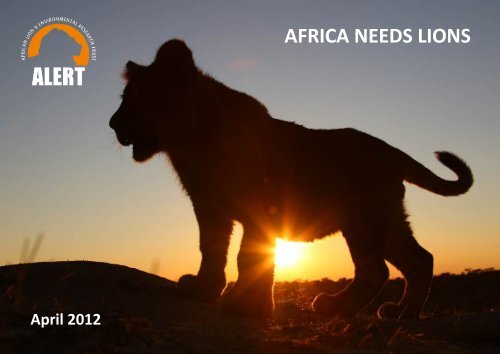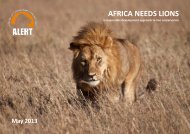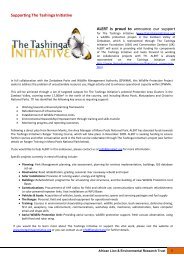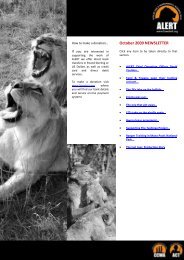AFRICA NEEDS LIONS - African Lion & Environmental Research Trust
AFRICA NEEDS LIONS - African Lion & Environmental Research Trust
AFRICA NEEDS LIONS - African Lion & Environmental Research Trust
- No tags were found...
You also want an ePaper? Increase the reach of your titles
YUMPU automatically turns print PDFs into web optimized ePapers that Google loves.
April 2012<strong>AFRICA</strong> <strong>NEEDS</strong> <strong>LIONS</strong>
THE NGAMO PRIDEFollowing the loss of two litters in quick succession the decision was made to fitNgamo lioness, Phyre, with a contraceptive in order that her body could recover from thepregnancies. The date was set for the 7 th March and after tracking down Phyre and identifyingthe rest of the pride’s locations plenty of patient waiting ensued to get a clear shot to dart her.Once she was lights out, and the rest of the pride had moved off sufficiently, Antelope Park’sexperienced lion handlers loaded Phyre onto a stretcher and the vehicle whisked her off to thesite’s management enclosure. Whilst sedated the implant was fitted, her radio collar removed forrefurbishment, a general once over given by the lion’s manager and body measurements taken.After the reversal was given, Phyre was up on her feet again in no time with no ill effects evident.With Phyre re-joining the pride after her procedure, as the month progressed the youngestmembers of the pride, AS4 and AS5, have become more integrated and are now frequently seenwith the adults.You can follow the progress of theNgamo pride on their own blog page.Simply click here to find out more.You can also subscribe to be notifiedwhen a new article is posted.
With five cubs in the family, the pride females have been noted to join in roaring bouts less frequently –Milo however is still bellowing for the entire world to hear. This is completely normal as lionesses will notadvertise their position if they have cubs. But the cubs themselves seem to be less wary and KE3 and KE4gallantly joined in with Milo’s daily roar on the 10 th March.Whilst Kenge and Ashanti’s litters find their feet in pride life, AT1 has also had to re-learn a few things. The15-month old lost her two siblings at a young age, and while Nala and Narnia did a pretty good job ofrediscovering their inner cubs and taking on the role of her primary playmates, there really is no substitutefor learning alongside your peers. However, over March is seems that AT1 has realised she’s not quite readyto be a lioness just yet, and has decided to go back to basics with her younger half-siblings. Despite being ata disadvantage earlier on in life, she definitely has the upper-hand now; being some 10 months older thanthe youngsters and a good few kilograms heavier. AT1 is blossoming in her new role of playground bully asshe throws her weight around. Well, she is her father’s daughter…Please show your support of the Ngamo pride hereincluding our adopt a lion program
The elephants are back… We werecaught slightly by surprise on the 29 th March in theMosi-oa-Tunya National Park by a 17 strong bachelorgroup of elephants.To a greater extent the majority of Livingstone’sseasonal elephant population left the area duringDecember last year. Since then the small numberswhich stayed behind are fairly difficult to find and nosightings have been made since mid-January.Work still continues during these quiet months torecord indirect activity however. We weren’texpecting any arrivals for a good few weeks and sowere fairly overjoyed and wholly unprepared for thisgroup’s emergence that afternoon. Looking atprevious years’ information it’s likely we still have abit of a wait before regular sightings and big herdnumbers make a comeback, but this served as awelcome early warning system!Regional changes in weather patterns may havesomething to do with the early arrival of theelephants back to the Mosi-oa-Tunya National Park.You can find out more about this research programhere.
The 10-year old wild lioncurrently being held at the DambwaForest (who goes by the name of Dynamite)hopefully moved one step closer to a decisionconcerning his future.To re-cap this story, <strong>Lion</strong> Encounter andALERT were involved in a joint operation withthe Zambia Wildlife Authority (ZAWA) andother operators in the Livingstone area tocapture a wild lion after he moved into avillage on the outskirts of the town and beganpredating upon livestock. The lion originatesfrom Zimbabwe’s Hwange National Parkwhere he was well known by researchers.Dr. Ian Parsons – who darted the lion duringthe capture process – returned to Livingstoneat the start of March to take blood samplesfor DNA and disease testing. Such informationwill be considered by ZAWA when consideringa long-term plan for the lion either withinZambia or for relocation back to Zimbabwe.Being of wild origin and not comfortable withmanagement gates and enclosures, staff at<strong>Lion</strong> Encounter have been unable to clean theenclosure in which he is being held since hisarrival. Therefore, whilst sedated a team ofsome 40 volunteers and program staff tookthe opportunity to dispose of old bones andfaeces, slash the grass in the enclosure toreduce tick numbers and allow bettervisibility of his condition, to clean water pans,conduct vital maintenance to the fence lineand collect measurements for researchpurposes.Once all work was complete Dynamite wasgiven a reversal shot and was on his feet andback to his usual grumpy self within minutes.
ALERT attends our partner <strong>Lion</strong>Aid’slion range state conference in JohannesburgDear DavidAs discussed previously, we would really appreciate your attendance at this conference and hope you can make the time available.We are <strong>Trust</strong>ees of <strong>Lion</strong>Aid, an international conservation foundation specifically concerned with the declining population status of <strong>African</strong> lions. You are doubtless aware ofthe highly significant reduction in numbers of this species across all range states. There might have been 200,000 lions on the continent in the 1960s, but these days realisticestimates do not exceed more than 25,000. Within the past few years, lions are reported to have become extinct in Cote d’Ivoire, Ghana, and Republic of the Congo.This decline was largely attributable to loss of habitat and conflict with human/livestock populations in the past. More recently, trade issues (especially lion sport hunting)have become an important additional source of mortality for populations already in rapid decline.As a component of our desire to contribute to informed lion conservation plans, we have scheduled a conference among a number of <strong>African</strong> lion range states to solicitopinions for a proposal to uplist lions from CITES Appendix II to CITES Appendix I at the upcoming Conference of Parties in Thailand in 2013. As you know, this uplisting wouldnot prevent lion trophy hunting, but could lead to better conservation measures for a species that, despite very significant declines in population numbers and geographicrange, is still subject to significant trade in some regions. In addition, the conference will establish latest estimated population numbers in the represented range states,progress of their National <strong>Lion</strong> Conservation Plans, and measures taken by range states that allow trade to ensure that such commerce is not negatively affecting lionconservation status.Funding for the conference has been provided to <strong>Lion</strong>Aid by the UK Government through the Department of Environment, Food and Rural Affairs (DEFRA) and will take placeon 29th and 30th March 2012 in Johannesburg and we are inviting Management Authority and Scientific Authority delegates from Senegal, Cameroon, Nigeria, Namibia,South Africa, Botswana, Mozambique, Zambia, Malawi, Uganda, Tanzania, Ethiopia and Kenya. We will also try to arrange for a representative from the CITES Secretariat to bepresent to advise on technical issues which may arise during the proceedings. All invited NGOs will receive observer status and we trust will contribute to the formulation ofconference resolutions. Your input would be very much valued and we would therefore like to take this opportunity to invite you to participate in this conference.We apologise for the short notice we have given you for this event. We were awarded the funds very recently and regulations require expenditure by March 31st. We wouldbe grateful if you reply at your earliest convenience if you can attend so that we can proceed to finalising all the logistical arrangements for the attendees,With all best regards,Pieter and ChrisDr Pieter W Kat PhD and Ms Christine Macsween, <strong>Trust</strong>ees – <strong>Lion</strong>Aid, Registered Charity No 1137606
Whilst we shall await a full report from <strong>Lion</strong>Aid on the proceedings of the lion range state conference before publishing further details of the event, ALERT can confirm that theconference was highly productive. A number of resolutions proposed by the range states themselves were agreed by all participants and which we believe will make significant contributions tothe conservation of the species.In the meantime, we would like to draw your attention to a discussion of an IUCN publication from 2009 that considers the socio-economic impact of lion trophy hunting. Highlights are providedbelow, whilst the full article is available on our web site in our articles section, and can be discussed on our forum.• Where management levels are similar, wildlife is much better conserved in protected areas than inhunting areas;• Hunting areas are much less resistant to outside pressures (poaching for example) than protectedareas;• Economic returns from trophy hunting are minimal, and the land-use returns are much lower thanwhat could be gained by raising livestock, for example;• Hunting contributions to GDP and national budgets are insignificant, especially in light of the largeareas of land set aside for hunting;• Returns for local populations, even when administered by community-based natural resourcemanagement projects, are insignificant and is no incentive for communities to stop poaching andagricultural encroachment;• The number of people employed (estimated at 15,000) is miniscule compared to the 150 millionpeople living in 8 main trophy hunting nations, and setting aside 16.5% of the land area for trophy huntingis a questionable decision given that trophy hunting does not provide any significant level ofsocioeconomic return;• Good governance is largely absent from the trophy hunting industry, and those in charge are notready to share any level of control. Lack of transparency does not serve the State, local communities, orconservation.• Hunting had, and still can have a role in conservation if considerable changes can be made. Currently,it contributes very little economically, has no social role, and makes no contribution to good governance.Consequently, trophy hunting has an overall negative effect as far as development is concerned;• Environment has to be seen as a global good, not for the exclusive use of private interests orminorities.
ALERT’s facilitated research programwelcomes our first PhD level students this month.The first, Derek O’Donnell joins us from Utah State Universityunder the supervision of Dr. Julie Young. He has the highlyenviable task of observing the Ngamo pride’s cubs daily as part ofa comparison of the development of wild and captive-origin lioncubs. The aim is to clarify what we believe to be true, thatcaptive-origin lion cubs raised under the conditions provided byour release protocol can learn the skills that make them suitablefor release into the wild.Next year Derek will transfer to a free-ranging lion population torepeat the research program currently undertaken with theNgamo pride to collect the necessary data that will facilitate thecomparison.You can read more about this study here.Our second student joins us from Montana University. LauraBecarra has joined the team in Livingstone to explore the conceptof equity in the context of nature based tourism (NBT), using acase study of ALERT & our partner <strong>Lion</strong> Encounter.Specifically, the various conceptualizations of equity are identifiedand their influence on NBT expectations, decision-making, andoutcomes will be analyzed. To the layman, the study is lookingprincipally at benefit sharing and how our program’s contributionto this is reflected in how stakeholders perceive our programsand the support provided to conservation efforts as a result.Laura is supervised by Prof. Wayne Freimund & Dr NormaNickerson. You can read more about this study here.If you are considering undertaking athesis as part of your study in anydiscipline, and are keen to base yourfield research in Africa, then take a lookat our facilitated research program.
If you have ever wanted to do a parachute jump here is your chance (UK only). ALERT are looking for hundreds of adventurous volunteers to make a fundraising parachutejump and if you raise enough in sponsorship you will get to jump for free! There are three types of jump available – an ‘Accelerated FreeFall’ where you can experience the thrill of skydivingsolo from up to 12,000 feet, a ‘Tandem Skydive’ from 10,000 feet attached to a professional instructor and a ‘Static Line’ jump which is performed solo from up to 3,000 feet - and you can jumpfrom any one of over twenty British Parachute Association approved airfields across the UK. No experience is necessary as all training is given and if you raise from £360 (depending on the typeof jump you choose) you will receive your jump for free. So if you would like to make a thrilling skydive please email us at info@lionalert.org and we will send you a full information pack andeverything you need to take part in the experience of a lifetime.
THE DAMBWA PRIDESightings of the pride in Dambwa were hard tocome by this month. As we reach the end of the rainy seasonthe water has well and truly rejuvenated the site – withtowering 6-8ft tall grass in places. Between the 3 rd and 18 thMarch we barely saw them at all, and when we did it was briefglimpses as they crossed roads or the odd tail flicking as theymoved through the thick vegetation.Finally on the morning of the 18 th they had all settled along oneof the roads in the centre of the site which still gives relativelyclear views. Kwandi, Kela, Temi and Zulu were sprawled alongthe road, whilst Leya, Loma and Rusha could be heard gnawingaway on their most recent meal in the grass. As the morningprogressed and the temperature rose the inevitable happened,and one by one they slunk off back into the grass to find someshade under the trees. A brief encounter, but much-anticipatednonetheless.You can follow the progress of the Dambwapride on their own blog page. Simply clickhere to find out more. You can alsosubscribe to be notified when a new article isposted.
Decent viewing continued into the 19 th when thepride was relaxing in Chisamu. A brief moment ofhi-jinks between Kela and Zulu roused the entiregroup and before long the pride were off andmarching out of Chisamu and into Sahara.As they weaved in and out of the tall grass theyeventually made their way into a large thicket witha clearing in the middle. Drinking greedily from anatural water pan which has been created in theclearing from the rains, they sprawled out in thelate afternoon sun.In an almost synchronised move, most of the pridetilted their noses up and began to sniff the air.Unfortunately it wasn’t prey they were scenting,but an incoming storm. A useful early warningsystem and we took our cue to leave.After a couple of days of fantastic sightings it wasback to business as usual the following day inKariba. The morning started off well enough withKela, Loma and Zulu visible; the rest of the lionswere back in the grass.Shortly before breakfast Rusha emerged from thegrass and initiated a short move with the other sixdutifully following. For a few all-too brief minuteswe watched as they ambled along the road,socialising, but then one by one they vanished backinto the grass.
*The Daily PrideJackie’s off andrunning again!The new ALERT website is nowlive! Take a look around here*Party with the prideIf you live near Godalming inSurrey (or even if you don’t), pleasesupport Mickey Channings as sheraises funds for ALERT. Mickeyis hosting Party with the Pride on20 th April.Tickets to the event cost £8.50 and canbe reserved by emailing Mickey atmichaela.channings@virginmedia.comThe Party will include live music fromJenny and the Jellyfish, face-paintingand cake sales. Also, the evening’shighlight is an auction including a copyof the <strong>Lion</strong> Country book signed byDavid Youldon and original artwork ofthe lions in the Rehabilitation & Releaseinto the Wild Program.If you can’t make it to Party with thePride, please consider donating to serialmarathon runner, Jackie Abell. Jackiehas run marathons in the past to helpraise funds for our programs. This yearshe’s outdone herself and is runningnot one but two marathons.First up is the Brighton Marathon on15 th April and the second round comeson the 24 th June in Lancaster. If you cansupport Jackie’s sterling efforts, pleasevisit her fundraising page hereFacilitated <strong>Research</strong> student AliFlemming has joined <strong>Lion</strong> Encounterin Livingstone for three months.Ali is studying Zoology, Evolution andEcology at the Australian NationalUniversity. Her project is focussing on asocial network analysis of a number ofthe Zambian project’s lions – includingthe seven walking cubs and the Dambwarelease pride (grass and visibilityallowing). Ali was a volunteer at theproject two years ago and it’s great tohave her back with us, and wish her thebest for her studies.Fifteen-month old Zamfara made her first kill in the Mosioa-TunyaNational Park on the 6 th March. An encounter witha monitor lizard on an afternoon walk with sister Zaria, sawZamfara pounce before Zaria joined in for a tug of war.
Ormiston Victory Academy hasannounced their partnership withALERT in their latest newsletter. Inside theytalk about how they are supporting ourefforts, whilst using ALERT's educationalmaterials within their school's classes. Formore information about bringing lions intoyour school's lessons please contactrae@lionalert.orgThis image is of one ofseveral new lions that have been seenat our affiliate program in the MaraNaboisho Conservancy. Theseencounters come fairly quickly after twounknown female lions and their cubswere found in the conservancy.After a year of work by dozensof people, we are pleased to announcethe launch of ALERT’s new web site.We have greatly improved the descriptions ofwhat we do to make our approach toconservation easier to understand. Ourprojects are more clearly defined andpresented, and options to volunteer, internand study with us, or through our affiliateprograms, are easier to find. Our about lionsresource section is aimed to be the mostcomprehensive guide to lions anywhere onthe web, and of course we provide a host ofnew and easier ways to support our work.There is also a subscription service in ournews section to ensure you don’t miss athing.There are a few functions still to completeand I am sure we will find a fair number ofmissing links and textual errors over thecoming weeks.We are also still working on improving howthe site looks on your various mobile phones.So, if you find anything that needs fixing, orhave suggestions about something wemissed, please drop a quick email to us atinfo@lionalert.org so we can try and resolvethe issue.Other than that, please enjoy the site, it hasbeen created with great love for a purpose;to advance the conservation of Africa’swildlife to the benefit of Africa’s people.ALERT’s you tube channel is upand running. For a variety of filmsrelated to our work and about lions ingeneral please visit our channel.Do let us know if you of films you feelshould be added our channel to improvethis resource.To find our more about the two programsthat we support in this area please seethese links.Mara 1Mara 2No matter your interest, we have avolunteer program that will suit you!
ALERT would like to thank the followingindividuals and organisations who havecontributed financially or in-kind, or who haveencouraged others to support of our programsover this month:Jackie AbellSiobhan AdeusiLiz AllenEmily BakerRachel BalasuriyaLinni BarnettBritish Polythene IndustriesJ CarrollMichaela ChanningsJohn CookeK CooperSarah CrowtherK DevineSabine DiederichsKaren EverestV GeddesMarion HallBen HealeyLouise Homan-LakeP IrelandF JamiesonNatasha KennedyJoyce la VertueJ LoizidesYueyuan MaS MarshallJennifer McCayHelen MillerHeather MillingtonNeil MunroeSarah KingAnita PetrinjakJulie PennyDaniella RodriquesIssiah SakhabuthCarol SandersonNikki SherwoodT SzpiroCarl & Margaret UnderyIrene VoigtReece WalshDerek WattsMichael WattsHelen WilderspinStacey Wlodarek












